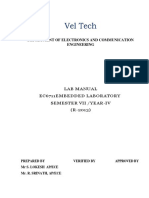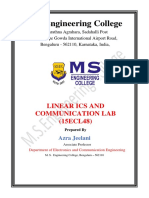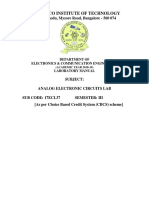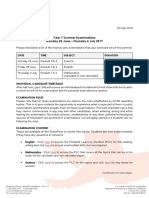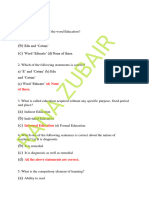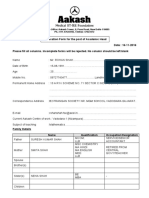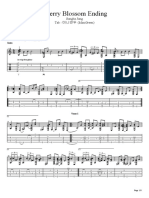Digital Systems and Design Lab Manual (Ece2152)
Uploaded by
subhadeep.banerji.cse28Digital Systems and Design Lab Manual (Ece2152)
Uploaded by
subhadeep.banerji.cse28DIGITAL SYSTEMS DESIGN LABORATORY MANUAL DEPARTMENT OF ECE
HERITAGE INSTITUTE OF TECHNOLOGY
LABORATORY MANUAL
PAPER NAME: DIGITAL SYSTEMS DESIGN LABORATORY
PAPER CODE: ECE2152
(Witheffectfromtheacademicyear2023 onwards)
DEPARTMENT OF
ELECTRONICSANDCOMMUNICATIONENGINEERING
Heritage Institute ofTechnology Page 1
DIGITAL SYSTEMS DESIGN LABORATORY MANUAL DEPARTMENT OF ECE
Table of Contents
1. Mission, Vision, PEO, PO, PSO of the Department ………………….………………03
Departmental Mission ……………………………………………………..03
Departmental Vision …………………………………………………….03
Program Educational Objective……………………………………………04
Program Outcome ……………………………………………………..05
Program Specific Outcome ………………………………………………..06
2. Course & Outcomes………………….…………………………………………….…07
Course structure ……………………...……………………………………07
Course Outcome .………………………………………………………….07
List of experiments ………………………………………………………...07
3. Laboratory Experiments………………………………………………….………….09
4. Appendix I : Mapping between Experiments and CO ……………………….…….
5. Appendix II. Course Articulation Matrix…………………………………………...
6. Appendix III: Data Sheets…………………………………………..………………
7. Appendix IV: Evaluation Scheme & Rubrics for Assessment …………………..
Heritage Institute ofTechnology Page 2
DIGITAL SYSTEMS DESIGN LABORATORY MANUAL DEPARTMENT OF ECE
Vision of Electronics and Communication Engineering Department
The degree holders of the Department will carry the image of the institute and the department
in India and the World through their commitment and success. They will prove themselves to
be good, sincere and successful professionals and teachers. They will prove themselves as
good, caring and responsible citizens.
Mission of Electronics and Communication Engineering Department
Students with degrees from Electronics and Communication Engineering (ECE) Department of
Heritage Institute of Technology will
1. Acquire specialized knowledge in the desired domains
2. Be able to analyze a problem in the given areas and be able to solve it in efficient
manner.
3. Have confidence and knowledge to start new business activities and show
entrepreneurship skills.
4. Develop passion for more studies and R & D.
5. Inherit leadership qualities for society and workplace.
Program Educational Objectives of Electronics and Communication
Engineering Department
The graduate students with the B.Tech. (Electronics and Communication Engineering), degree
from Heritage Institute of Technology, Kolkata are expected to attain the following after a few
years of getting this degree:
They will attain:
1. Strong foundation: establish their ability to analyze and synthesize current Electronics
and Communication Engineering practices by assimilating its basic and advanced approaches
on way to become successful professionals in industries.
Heritage Institute of Technology Page 3
DIGITAL SYSTEMS DESIGN LABORATORY MANUAL DEPARTMENT OF ECE
2. Critical & Innovative Thinking: prove their research orientation by their ability to
handle versatile problems in Communication and related field by virtue of their knowledge
acquired in course of the degree.
3. Leadership, coordination & Group Activity: demonstrate their ability to work in
teams. They will prove themselves as good natured and well - behaved members of working
teams as well as leaders in various diverse industries.
4. Implementation of knowledge gained through interaction & effective
communication skills in work places: show their learning and teaching abilities and their
communication efficiency in their work places
Program Outcome & Program Specific Objective
Program Outcomes :
Engineering Graduates will be able to:
PO1: Engineering knowledge: Apply the knowledge of mathematics, science, engineering
fundamentals, and an engineering specialization to the solution of complex engineering
problems.
PO2: Problem analysis: Identify, formulate, review research literature, and analyze complex
engineering problems reaching substantiated conclusions using first principles of mathematics,
natural sciences, and engineering sciences.
PO3: Design/development of solutions: Design solutions for complex engineering problems
and design system components or processes that meet the specified needs with appropriate
consideration for the public health and safety, and the cultural, societal, and environmental
considerations.
PO4 : Conduct investigations of complex problems: Use research-based knowledge and
research methods including design of experiments, analysis and interpretation of data, and
synthesis of the information to provide valid conclusions.
Heritage Institute of Technology Page 4
DIGITAL SYSTEMS DESIGN LABORATORY MANUAL DEPARTMENT OF ECE
PO5: Modern tool usage: Create, select, and apply appropriate techniques, resources, and
modern engineering and IT tools including prediction and modeling to complex engineering
activities with an understanding of the limitations.
PO6 : The engineer and society: Apply reasoning informed by the contextual knowledge to
assess societal, health, safety, legal and cultural issues and the consequent responsibilities
relevant to the professional engineering practice.
PO7: Environment and sustainability: Understand the impact of the professional engineering
solutions in societal and environmental contexts, and demonstrate the knowledge of, and need
for sustainable development.
PO8: Ethics: Apply ethical principles and commit to professional ethics and responsibilities
and norms of the engineering practice.
PO9: Individual and team work: Function effectively as an individual, and as a member or
leader in diverse teams, and in multidisciplinary settings.
PO10: Communication: Communicate effectively on complex engineering activities with the
engineering community and with society at large, such as, being able to comprehend and write
effective reports and design documentation, make effective presentations, and give and receive
clear instructions.
PO11: Project management and finance: Demonstrate knowledge and understanding of the
engineering and management principles and apply these to one’s own work, as a member and
leader in a team, to manage projects and in multidisciplinary environments.
PO12: Life-long learning: Recognize the need for, and have the preparation and ability to
engage in independent and life-long learning in the broadest context of technological change.
Heritage Institute of Technology Page 5
DIGITAL SYSTEMS DESIGN LABORATORY MANUAL DEPARTMENT OF ECE
Program Specific Outcomes:
The graduates of the department will attain:
PSO1: The ability to absorb and apply fundamental knowledge of core Electronics and
Communication Engineering subjects in the analysis of various types of integrated electronic
systems as well as to interpret and synthesize the experimental data leading to valid
conclusions.
PSO2: Competence in using electronic modern IT tools (both software and hardware) for the
design and analysis of complex electronic systems in furtherance to research activities.
PSO3: The capability to apply the concepts of Electronics and Communication Engineering to
design and develop a variety of components and systems for applications including, but not
limited to, signal processing, Communication, Embedded systems, VLSI and control system.
PSO4: Excellent adaptability to changing work environment, good interpersonal skills as a
leader in a team in appreciation of professional ethics and societal responsibilities.
Heritage Institute of Technology Page 6
DIGITAL SYSTEMS DESIGN LABORATORY MANUAL DEPARTMENT OF ECE
Syllabus of Digital Systems Design Laboratory
Course Name: Digital Systems Design Lab
Course Code:ECE2152
Contact L T P Total Credit
Hours per Points
week 0 0 2 2 1
Course Outcomes:
The students after finishing this course will be able to :
ECE2152.1. Design code converters.
ECE2152.2. Design arithmetic circuits.
ECE2152.3. Design combinational logic circuits.
ECE2152.4. Realize flip-flops and counters.
List of Experiments:
1. Realization of basic gates using Universal logic gates.
2. Realization of code conversion circuits - BCD to Excess-3 and vice-versa.
3. Construction of simple arithmetic circuits - Adder, Subtractor.
4. Design of Parity Bit Generator and Checker circuits.
5. Construction of Decoder circuit using logic gates.
6. Construction of Multiplexer circuit using logic gates and realization of different
combinational logic
circuits using Multiplexer.
7. Design of 2-Bit Comparator Circuit.
8. Realization of RS, D and JK flip-flops using universal logic gates.
9. Realization of Asynchronous Up or Down counter.
10. Realization of Synchronous Up or Down counter.
11. Realization of Ring and Johnson’s counters.
Heritage Institute of Technology Page 7
DIGITAL SYSTEMS DESIGN LABORATORY MANUAL DEPARTMENT OF ECE
DIGITAL SYSTEMS DESIGN LAB (ECEN2152)
Contents:
EXPERIMENT
EXPERIMENT NAME
NO
Realization of basic gates using Universal
1
logic gates
Code conversion circuits- BCD to Excess-3
2
and vice versa
3 4-bit parity generator & comparator circuits
Construction of simple arithmetic circuits-
4 Adder, Substractor.
Construction of simple Decoder &
5 Multiplexer circuits using logic gates.
Realization of different combinational
6 circuits using Multiplexers.
Realization of RS, JK, and D flip-flops using
7 Universal logic gates.
Realization of Asynchronous Up/Down
8 counters.
Realization of Synchronous Up/Down
9 counters.
Design of Sequential Counter with irregular
10 sequences.
11 Realization of Ring and Johnson’s counters.
Heritage Institute of Technology Page 8
DIGITAL SYSTEMS DESIGN LABORATORY MANUAL DEPARTMENT OF ECE
EXPERIMENT 01
REALIZATION OF BASIC GATES USING
UNIVERSAL LOGIC GATES
OBJECTIVE:
The purpose of this experiment is to verify the conversion of any gate using only
universal logic- gates.
BASIC LOGIC GATES USING NAND LOGIC
LOGIC DESIRED GATE NAND CONSTRUCTION
TRUTH TABLE
GATE
Input A Input B Output
NAND 0 0 1
0 1 1
1 0 1
1 1 0
Input A Output
NOT 0 1
1 0
Input A Input B Output
AND 0 0 0
0 1 0
1 0 0
1 1 1
Input A Input B Output
0 0 0
OR 0 1 1
1 0 1
1 1 1
Input A Input B Output
0 0 1
NOR 0 1 0
1 0 0
1 1 0
Input A Input B Output
0 0 0
XOR 0 1 1
1 0 1
1 1 0
Input A Input B Output
1
0 0
XNOR 0
0 1
0
1 0
1 1 1
Heritage Institute of Technology Page 9
DIGITAL SYSTEMS DESIGN LABORATORY MANUAL DEPARTMENT OF ECE
BASIC LOGIC GATES USING NOR LOGIC
LOGIC DESIRED GATE NOR CONSTRUCTION
TRUTH TABLE
GATE
Input Input Outpu
t
A B
NAND 0 0 1
0 1 1
1 0 1
1 1 0
Input A Output
NOT 0 1
1 0
Input Input
Outpu
t
A B
AND 0 0 0
0 1 0
1 0 0
1 1 1
Input Input
Outpu
t
A B
0 0 0
OR
0 1 1
1 0 1
1 1 1
Input Input Outpu
t
A B
0 0 1
NOR
0 1 0
1 0 0
1 1 0
Input Input Outpu
t
A B
0 0 0
XOR
0 1 1
1 0 1
1 1 0
Outpu
Input Input t
A B
1
0 0
XNOR 0
0 1
0
1 0
1 1 1
Heritage Institute of Technology Page 10
DIGITAL SYSTEMS DESIGN LABORATORY MANUAL DEPARTMENT OF ECE
APPARATUS REQUIRED:
Sl.No. COMPONENT SPECIFICATION QTY.
1) Digital Trainer Kit . 1
2) Bread Board . 1
3) Connecting Wires Single Strand As Required
4) Wire Stripper . 1
5) Tweezers . 1
6) IC 7400 NAND Gate 2
7) IC 7402 NOR Gate 2
PROCEDURE:
1) Draw the NAND & NOR equivalent circuit of the basic gates and identify the pin no. of
each IC
2) Construct the circuit in Digital Trainer Kit / Bread Board using the specified IC and
connecting wires
3) Connect +5V power supply, Inputs and Outputs from Trainer Kit.
4) Verify the input/output combinations according to the truth table.
CONCLUSION:
Heritage Institute of Technology Page 11
DIGITAL SYSTEMS DESIGN LABORATORY MANUAL DEPARTMENT OF ECE
EXPERIMENT 02
Code conversion circuits
BCD toExcess-3 and vice-versa.
OBJECTIVE:
To design and implement 4-bit
1) BCD to excess-3 code converter
2) Excess-3 to BCD code converter
THEORY:
While converting from BCD to Exces-3, the circuit accepts 4 bit BCD data as input and
generates 4 bit Exces-3 data. In BCD only 0 to 9 are valid inputs and 10 to 15 treated as
don't care combinations.
During Exces-3 to BCD conversion, the valid inputs combinations are from 3 to 12 while
0, 1, 2, 13, 14, 15 are don't care condition.
The input variable are designated as B3, B2,B1, B0 and the output variables are
designated as E3,E2,E1, E0. From the truth table, combinational circuit is designed. The
Boolean functions are obtained from K-Map for each output variable.
A two- level logic diagram may be obtained directly from the Boolean expressions
derived by the maps. These are various other possibilities for a logic diagram that
implements this circuit
Heritage Institute of Technology Page 12
DIGITAL SYSTEMS DESIGN LABORATORY MANUAL DEPARTMENT OF ECE
BCD TO EXCESS-3 CONVERTER
TRUTH TABLE:
BCD input Excess – 3 output
B3 B2 B1 B0 E3 E2 E1 E0
0 0 0 0 0 0 1 1
0 0 0 1 0 1 0 0
0 0 1 0 0 1 0 1
0 0 1 1 0 1 1 0
0 1 0 0 0 1 1 1
0 1 0 1 1 0 0 0
0 1 1 0 1 0 0 1
0 1 1 1 1 0 1 0
1 0 0 0 1 0 1 1
1 0 0 1 1 1 0 0
1 0 1 0 x x x x
1 0 1 1 x x x x
1 1 0 0 x x x x
1 1 0 1 x x x x
1 1 1 0 x x x x
1 1 1 1 x x x x
Heritage Institute of Technology Page 13
DIGITAL SYSTEMS DESIGN LABORATORY MANUAL DEPARTMENT OF ECE
K-Map for E3:
E3=B3+B2(B1+B0)
K-Map for E2:
Heritage Institute of Technology Page 14
DIGITAL SYSTEMS DESIGN LABORATORY MANUAL DEPARTMENT OF ECE
K-Map for E1:
K-Map for E0:
Heritage Institute of Technology Page 15
DIGITAL SYSTEMS DESIGN LABORATORY MANUAL DEPARTMENT OF ECE
LOGIC DIAGRAM :
Heritage Institute of Technology Page 16
DIGITAL SYSTEMS DESIGN LABORATORY MANUAL DEPARTMENT OF ECE
EXCESS-3 TO BCD CONVERTER :
TRUTH TABLE:
Excess – 3 Input BCD Output
E3 E2 E1 E0 B3 B2 B1 B0
0 0 1 1 0 0 0 0
0 1 0 0 0 0 0 1
0 1 0 1 0 0 1 0
0 1 1 0 0 0 1 1
0 1 1 1 0 1 0 0
1 0 0 0 0 1 0 1
1 0 0 1 0 1 1 0
1 0 1 0 0 1 1 1
1 0 1 1 1 0 0 0
1 1 0 0 1 0 0 1
Derive the equations of B3, B2, B1 and B0 using K maps. The expressions are as follows:
B3 = E3E2 + E3E1E0
̅̅̅ ̅̅̅̅̅̅ ̅̅̅ ̅̅̅̅̅̅ ̅̅̅ (̅̅̅̅̅̅ ̅̅̅)̅̅̅
B1 = E1 E0
̅̅̅
Heritage Institute of Technology Page 17
DIGITAL SYSTEMS DESIGN LABORATORY MANUAL DEPARTMENT OF ECE
LOGIC DIAGRAM:
E0 B0
E1 B1
E2 B2
E3 B3
APPRATUS REQUIRED:
Sl.No. COMPONENT SPECIFICATION QTY.
1) Digital Trainer Kit . 1
2) Bread Board . 1
3) Connecting Wires Single Strand As Required
4) Wire Stripper . 1
5) Tweezers . 1
6) IC 7486 X-OR GATE 1
7) IC 7408 AND GATE 1
8) IC 7432 OR GATE 1
9) IC 7404 NOT GATE 1
Heritage Institute of Technology Page 18
DIGITAL SYSTEMS DESIGN LABORATORY MANUAL DEPARTMENT OF ECE
PROCEDURE:
1) Draw the required circuits of the code conversion and identify the pin no. of each
IC
2) Construct the circuit in Digital Trainer Kit / bread board using the specified
IC and connecting wires
3) Connect +5V power supply, Logical Inputs and Outputs from Trainer Kit.
4) Verify the input/output combinations according to the truth table.
CONCLUSION:
Heritage Institute of Technology Page 19
DIGITAL SYSTEMS DESIGN LABORATORY MANUAL DEPARTMENT OF ECE
EXPERIMENT 03
DESIGN AND IMPLEMENTATION OF PARITY
GENERATOR AND CHECKER&MAGNITUDE
COMPARATOR
OBJECTIVE:
To design and implement
1) 3 – bit odd parity generator and checker
2) 2 – bit magnitude comparator using basic gates.
3- BIT ODD PARITY GENERATOR AND CHECKER
THEORY:
A parity bit is used for the purpose of detecting errors during transmission of binary
information. A parity bit is an extra bit included with a binary message to make the
number of 1’s either odd or even. The message including the parity bit is transmitted and
then checked at the receiving end for errors. An error is detected if the checked parity
does not correspond with the one transmitted. The circuit that generates the parity bit in
the transmitter is called a parity generator and the circuit that checks the parity in the
receiver is called a parity checker.
In even parity the added parity bit will make the total number of 1’s even and in odd
parity the added parity bit will make the total number of 1’s odd.
In a three bit odd parity generator the three bits in the message together with the parity
bit are transmitted to their destination, where they are applied to the parity checker
circuit. The parity checker circuit checks for possible errors in the transmission.
Since the information was transmitted with odd parity the four bits received must have an
odd number of 1’s. An error occurs during the transmission if the four bits received have
an even number of 1’s, indicating that one bit has changed during transmission. The
output of the parity checker is denoted by PEC (parity error check) and it will be equal to
1 if an error occurs, i.e., if the four bits received has an even number of 1’s.
Heritage Institute of Technology Page 20
DIGITAL SYSTEMS DESIGN LABORATORY MANUAL DEPARTMENT OF ECE
ODD PARITY GENERATOR
TRUTH TABLE:
INPUT
OUTPUT
(3-bit message)
( Odd Parity bit)
A B C P
0 0 0 1
0 0 1 0
0 1 0 0
0 1 1 1
1 0 0 0
1 0 1 1
1 1 0 1
1 1 1 0
Derive the expression of P using K-map.
LOGIC DIAGRAM: ODD PARITY GENERATOR
Heritage Institute of Technology Page 21
DIGITAL SYSTEMS DESIGN LABORATORY MANUAL DEPARTMENT OF ECE
ODD PARITY CHECKER
INPUT OUTPUT
( four bit message Received) (Parity error check)
A B C P X
0 0 0 0 1
0 0 0 1 0
0 0 1 0 0
0 0 1 1 1
0 1 0 0 0
0 1 0 1 1
0 1 1 0 1
0 1 1 1 0
1 0 0 0 0
1 0 0 1 1
1 0 1 0 1
1 0 1 1 0
1 1 0 0 1
1 1 0 1 0
1 1 1 0 0
1 1 1 1 1
From the truth table the expression for the output parity checker bit is,
X (A, B, C, P) = Σ (0, 3, 5, 6, 9, 10, 12, 15)
Derive the expression of X using K-map.
LOGIC DIAGRAM: ODD PARITY CHECKER
Heritage Institute of Technology Page 22
DIGITAL SYSTEMS DESIGN LABORATORY MANUAL DEPARTMENT OF ECE
2 – BIT MAGNITUDE COMPARATOR USING BASIC GATES
THEORY:
A magnitude comparator is a combinational circuit that compares two numbers A and B.
The outcome of the comparator is specified by three binary variables that indicate
whether A>B, A=B or A<B.
A =A1A0
B =B1B0
2 BIT MAGNITUDE COMPARATOR
TRUTH TABLE
A1 A0 B1 B0 A>B A=B A<B
0 0 0 0 0 1 0
0 0 0 1 0 0 1
0 0 1 0 0 0 1
0 0 1 1 0 0 1
0 1 0 0 1 0 0
0 1 0 1 0 1 0
0 1 1 0 0 0 1
0 1 1 1 0 0 1
1 0 0 0 1 0 0
1 0 0 1 1 0 0
1 0 1 0 0 1 0
1 0 1 1 0 0 1
1 1 0 0 1 0 0
1 1 0 1 1 0 0
1 1 1 0 1 0 0
1 1 1 1 0 1 0
Heritage Institute of Technology Page 23
DIGITAL SYSTEMS DESIGN LABORATORY MANUAL DEPARTMENT OF ECE
K- MAP:
Derive the expression of (A=B) using Boolean algebra as there are 4 isolated 1’
Heritage Institute of Technology Page 24
DIGITAL SYSTEMS DESIGN LABORATORY MANUAL DEPARTMENT OF ECE
LOGIC DIAGRAM:
A<B
A=B
A>B
APPARATUS REQUIRED:
Sl.No. COMPONENT SPECIFICATION QTY.
1) Digital Trainer Kit . 1
2) Bread Board . 1
3) Connecting Wires Single Strand AS REQUIRED
4) Wire Stripper . 1
5) Tweezers . 1
6) IC 7486 X-OR GATE 1
7) IC 7408 2 Input AND GATE 1
8) IC 7432 OR GATE 1
9) IC 7404 NOT GATE 1
10) IC 7411 3 Input AND GATE 2
Heritage Institute of Technology Page 25
DIGITAL SYSTEMS DESIGN LABORATORY MANUAL DEPARTMENT OF ECE
PROCEDURE:
1) Draw the required circuits and identify the pin no. of each IC
2) Construct the circuit in Digital Trainer Kit / bread board using the specified IC
and connecting wires
3) Connect +5V power supply, Logical Inputs and Outputs from Trainer Kit.
4) Verify the input/output combinations according to the truth table.
CONCLUSION:
Heritage Institute of Technology Page 26
DIGITAL SYSTEMS DESIGN LABORATORY MANUAL DEPARTMENT OF ECE
EXPERIMENT 04
CONSTRUCTION OF SIMPLE ARITHMETIC
CIRCUITS :ADDER, SUBTRACTOR.
To design and implement the following circuit using logic gates-
1) Half- Adder
2) Full- Adder using Half- Adder
3) Half- Subtractor
4) Full- Subtractor using Half- Subtractor
HALF - ADDER:
THEORY:
A half adder has two inputs for the two bits to be added and two outputs one from the
sum ‘ S’ and other from the carry ‘ c’ into the higher adder position. Above circuit is
called as a carry signal from the addition of the less significant bits sum from the X-OR
Gate the carry out from the AND gate.
TRUTH TABLE:
A B CARRY SUM
0 0 0 0
0 1 0 1
1 0 0 1
1 1 1 0
K-M
Heritage Institute of Technology Page 27
DIGITAL SYSTEMS DESIGN LABORATORY MANUAL DEPARTMENT OF ECE
FULL- ADDER USING HALF ADDER :
THEORY:
A full adder is a combinational circuit that forms the arithmetic sum of input; it consists
of three inputs and two outputs. A full adder is useful to add three bits at a time but a half
adder cannot do so. In full adder sum output will be taken from X-OR Gate, carry output
will be taken from OR Gate.
TRUTH TABLE:
A B C CARRY SUM
0 0 0 0 0
0 0 1 0 1
0 1 0 0 1
0 1 1 1 0
1 0 0 0 1
1 0 1 1 0
1 1 0 1 0
1 1 1 1 1
Derive the expression for Sum and carry required to realize the circuit
S = A ⊕ B ⊕ Cin
Cout = AB + Cin(A ⊕ B)
Heritage Institute of Technology Page 28
DIGITAL SYSTEMS DESIGN LABORATORY MANUAL DEPARTMENT OF ECE
LOGIC DIAGRAM:
´) ( ´ ´)
( )
HALF -SUBTRACTOR:
THEORY:
The half subtractor is constructed using X-OR and AND Gate. The half subtractor has
two input and two outputs. The outputs are difference and borrow. The difference can be
applied using X-OR Gate, borrow output can be implemented using an AND Gate and an
inverter.
TRUTH TABLE:
A B BORROW DIFFERENCE
0 0 0 0
0 1 1 1
1 0 0 1
1 1 0 0
Difference = A ⊕ B
Borrow = 𝐴̅̅̅𝐵
̅̅̅
LOGIC DIAGRAM:
Heritage Institute of Technology Page 29
DIGITAL SYSTEMS DESIGN LABORATORY MANUAL DEPARTMENT OF ECE
FULL -SUBTRACTOR USING HALF SUBTRACTOR :
THEORY:
The full subtractor is a combination of X-OR, AND, OR, NOT Gates. In a full subtractor
the logic circuit should have three inputs and two outputs. The two half subtractor put
together gives a full subtractor .The first half subtractor will be C and A B. The output
will be difference output of full subtractor. The expression AB assembles the borrow
output of the half subtractor and the second term is the inverted difference output of first
X-OR.
TRUTH TABLE:
A B C BORROW DIFFERENCE
0 0 0 0 0
0 0 1 1 1
0 1 0 1 1
0 1 1 1 0
1 0 0 0 1
1 0 1 0 0
1 1 0 0 0
1 1 1 1 1
Derive the expressions for Difference and Borrow required to realize the circuit;
LOGIC DIAGRAM:
Heritage Institute of Technology Page 30
DIGITAL SYSTEMS DESIGN LABORATORY MANUAL DEPARTMENT OF ECE
́ (̅̅̅ )
APPARATUS REQUIRED:
Sl.No. COMPONENT SPECIFICATION QTY.
1) Digital Trainer Kit . 1
2) Bread Board . 1
3) Connecting Wires Single Strand AS REQUIRED
4) Wire Stripper . 1
5) Tweezers . 1
6) IC 7408 2 INPUT AND GATE 1
7) IC 7432 OR GATE 1
8) IC 7404 NOT GATE 1
9) IC 7486 XOR GATE 1
PROCEDURE:
1) Draw the required circuits and identify the pin no. of each IC
2) Construct the circuit in Digital Trainer Kit / bread board using the specified IC and
connecting wires.
3) Connect +5V power supply, Logical Inputs and Outputs from Trainer Kit.
4) Verify the input/output combinations according to the truth table.
CONCLUSION:
Heritage Institute of Technology Page 31
DIGITAL SYSTEMS DESIGN LABORATORY MANUAL DEPARTMENT OF ECE
EXPERIMENT 05
CONSTRUCTION OF SIMPLE DECODER &
MULTIPLEXER CIRCUITS USING LOGIC GATES
OBJECTIVE:
To design and implement
1) 2 to 4 Line Decoder,
2) 4:1 Multiplexer.
2 TO 4 LINE DECODER:
THEORY:
A decoder is a circuit that changes a code into a set of signals. It is called a decoder
because it does the reverse of encoding, but we will begin our study of encoders and
decoders with decoders because they are simpler to design. A common type of decoder is
the line decoder which takes an n-digit binary number and decodes it into 2n data lines.
A typical application of a line decoder circuit is to select among multiple devices. A
circuit needing to select among sixteen devices could have sixteen control lines to select
which device should “listen”. With a decoder only four control lines are needed.
TRUTH TABLE:
SELECT OUTPUT
LINES
S0 S1
0 0 D0
0 1 D1
1 0 D2
1 1 D3
BLOCK & LOGIC DIAGRAM:
Heritage Institute of Technology Page 32
DIGITAL SYSTEMS DESIGN LABORATORY MANUAL DEPARTMENT OF ECE
4:1 MULTIPLEXER:
THEORY:
Multiplexing is the generic term used to describe the operation of sending one or more
analogue or digital signals over a common transmission line at different times or speeds
and as such, the device we use to do just that is called a Multiplexer.
The multiplexer, shortened to “MUX”, is a combinational logic circuit designed to
switch one of several input lines through to a single common output line by the
application of a control signal. Multiplexers operate like very fast acting multiple
position rotary switches connecting or controlling multiple input lines called “channels”
one at a time to the output.
TRUTH TABLE:
S1 S0 F
0 0 W
0 1 X
1 0 Y
1 1 Z
̅̅̅ ̅̅̅̅̅̅ ̅̅̅ ̅̅̅
LOGIC DIAGRAM:
Heritage Institute of Technology Page 33
DIGITAL SYSTEMS DESIGN LABORATORY MANUAL DEPARTMENT OF ECE
APPARATUS REQUIRED:
Sl.No. COMPONENT SPECIFICATION QTY.
1) Digital Trainer Kit . 1
2) Bread Board . 1
3) Connecting Wires Single Strand AS REQUIRED
4) Wire Stripper . 1
5) Tweezers . 1
6) IC 7411 3 INPUT AND GATE 2
7) IC 7408 2 INPUT AND GATE 1
8) IC 7432 OR GATE 1
9) IC 7404 NOT GATE 1
PROCEDURE:
1) Draw the required circuits and identify the pin no. of each IC
2) Construct the circuit in Digital Trainer Kit / bread board using the specified IC
and connecting wires
3) Connect +5V power supply, Logical Inputs and Outputs from Trainer Kit.
4) Verify the input/output combinations according to the truth table.
CONCLUSION:
Heritage Institute of Technology Page 34
DIGITAL SYSTEMS DESIGN LABORATORY MANUAL DEPARTMENT OF ECE
EXPERIMENT 06
REALIZATION OF DIFFERENT
COMBINATIONAL CIRCUIT USING MUX
OBJECTIVE:
1) To design a 8:1 MUX using 4:1 MUX and necessary logic gates
THEORY :
Heritage Institute of Technology Page 35
DIGITAL SYSTEMS DESIGN LABORATORY MANUAL DEPARTMENT OF ECE
The 74153 MUX has two separate 2-input/4-row MUXs on it. To create a
single 8-row truth table, we can start by implementing parts of the table on
different MUXs, and then combining the two separate outputs into one output.
... Remember, each strobe turns its MUX on when it is low.
APPARATUS REQUIRED:
Sl.No. COMPONENT SPECIFICATION QTY.
1) Digital Trainer Kit . 1
2) Bread Board . 1
3) Connecting Wires Single Strand AS REQUIRED
4) Wire Stripper . 1
5) Tweezers . 1
6) IC 74153 Dual 4:1 MUX 1
7) IC7404 NOT GATE 1
CONCLUSION:
Heritage Institute of Technology Page 36
DIGITAL SYSTEMS DESIGN LABORATORY MANUAL DEPARTMENT OF ECE
EXPERIMENT 07
REALIZATION OF RS-JK& D FLIP-FLOPS USING
UNIVERSAL LOGIC GATES
OBJECTIVE:
To design and implement the following circuit using logic gates-
1) S-R FLIP FLOP
2) J-K FLIP FLOP,
3) D FLIP FLOP
S-R FLIP FLOP:
THEORY:
The clocked SR flip-flop shown in the figure consist of a basic NOR flip-flop and two
AND gates.. The outputs of two AND gates remain at 0 as long as the clock pulse (or
CP) is 0, regardless of the S and R input values. When the clock pulse goes to 1,
information from the S and R input passes through to the basic flip-flop. With both S=1
and R= 1, the occurrence of a clock pulse causes both outputs to momentarily go to 0.
when the pulse is removed the state of the flip-flop is indeterminate, ie , either state may
result, depending on whether the set or reset input of the flip-flop remains a 1 longer than
the transition to 0at the end of the pulse.
STATE TABLE:
Heritage Institute of Technology Page 37
DIGITAL SYSTEMS DESIGN LABORATORY MANUAL DEPARTMENT OF ECE
TRUTH TABLE
LOGIC DIAGRAM:
J-K FLIP FLOP:
THEORY:
A J-K flip flop can also be defined as a modification of the S-R flip flop. The only
difference is that the intermediate state is more refined and precise than that of a S-R flip
flop.
The behaviour of inputs J and K is same as the S and R inputs of the S-R flip flop. The
letter J stands for SET and the letter K stands for CLEAR.
When both the inputs J and K have a HIGH state, the flip-flop switch to the complement
state. So, for a value of Q = 1, it switches to Q=0 and for a value of Q = 0, it switches to
Q=1.
The circuit includes two 3-input NAND gates. The output Q of the flip flop is returned
back as a feedback to the input of the NAND along with other inputs like K and clock
pulse [CP]. So, if the value of CP is ’1′, the flip flop gets a CLEAR signal and with the
condition that the value of Q was earlier 1. Similarly output Q’ of the flip flop is given as
a feedback to the input of the NAND along with other inputs like J and clock pulse [CP].
So the output becomes SET when the value of CP is 1 only if the value of Q’ was earlier
Heritage Institute of Technology Page 38
DIGITAL SYSTEMS DESIGN LABORATORY MANUAL DEPARTMENT OF ECE
The output may be repeated in transitions once they have been complimented for J=K=1
because of the feedback connection in the JK flip-flop. This can be avoided by setting a time
duration lesser than the propagation delay through the flip-flop. The restriction on the pulse
width can be eliminated with a master-slave or edge-triggered construction.
STATE TABLE:
TRUTH TABLE :
LOGIC DIAGRAM:
Heritage Institute of Technology Page 39
DIGITAL SYSTEMS DESIGN LABORATORY MANUAL DEPARTMENT OF ECE
Digital Systems & Design Laboratory
D FLIP FLOP:
THEORY:
The D flip-flop shown in figure is a modification of the clocked SR f flip-flop. The D
input goes directly into the S input and the complement of the D input goes to the R
input. The D input is sampled during the occurrence of a clock pulse. If it is 1, the flip-
flop is switched to the set state (unless it was already set). If it is 0, the flip-flop switches
to the clear state.
STATE TABLE:
LOGIC DIAGRAM:
APPARATUS REQUIRED:
Sl.No. COMPONENT SPECIFICATION QTY.
1) Digital Trainer Kit . 1
2) Bread Board . 1
3) Connecting Wires Single Strand AS REQUIRED
4) Wire Stripper . 1
5) Tweezers . 1
6) IC 7408 2 INPUT AND GATE 1
7) IC 7411 3 INPUT AND GATE 1
8) IC 7400 NAND GATE 1
9) IC 7404 NOT GATE 1
10) IC 7402 NOR GATE 1
Heritage Institute of Technology Page 40
DIGITAL SYSTEMS DESIGN LABORATORY MANUAL DEPARTMENT OF ECE
PROCEDURE:
1) Draw the required circuits and identify the pin no. of each IC
2) Construct the circuit in Digital Trainer Kit / bread board using the specified IC and
connecting wires.
3) Connect +5V power supply, Logical Inputs and Outputs from Trainer Kit.
4) Verify the input/output combinations according to the truth table.
CONCLUSION
Heritage Institute of Technology Page 41
DIGITAL SYSTEMS DESIGN LABORATORY MANUAL DEPARTMENT OF ECE
EXPERIMENT 08
REALIZATION OF ASYNCHRONOUS UP/DOWN
COUNTER
OBJECTIVE:
To design and realize asynchronous up & down counter.
THEORY:
In asynchronous counter the clock is applied to the first flip flop and the output of the
first stage is connected as a clock to the second stage and so on. In the asynchronous
up/down counter a control line M controls the counting sequence. If M=0, the counter
counts in the up direction and if M=1 the counter counts in the down direction.
LOGIC DIAGRAM:
APPARATUS REQUIRED:
Sl.No. COMPONENT SPECIFICATION QTY.
1) Digital Trainer Kit . 1
2) Bread Board . 1
3) Connecting Wires Single Strand AS REQUIRED
4) Wire Stripper . 1
5) Tweezers . 1
6) IC 7476 Dual JK Flip Flop 2
PROCEDURE:
1) Draw the required circuits and identify the pin no. of each IC
2) Construct the circuit in Digital Trainer Kit / bread board using the specified IC and
connecting wires.
3) Connect +5V power supply, Logical Inputs and Outputs from Trainer Kit.
4) Verify the input/output combinations according to the truth table.
CONCLUSION
Heritage Institute of Technology Page 42
DIGITAL SYSTEMS DESIGN LABORATORY MANUAL DEPARTMENT OF ECE
EXPERIMENT 09
REALIZATION OF SYNCHRONOUS UP/DOWN
COUNTER
OBJECTIVE:
To design and realize synchronous up & down counter.
THEORY:
In synchronous counters, the clock inputs of all the flip-flops are connected together and
are triggered by the input pulses. Thus, all the flip-flops change state simultaneously (in
parallel). The circuit below is a 4-bit synchronous counter. The J and K inputs of FF0 are
connected to HIGH. FF1 has its J and K inputs connected to the output of FF0, and the J
and K inputs of FF2 are connected to the output of an AND gate that is fed by the outputs
of FF0 and FF1. A simple way of implementing the logic for each bit of an ascending
counter (which is what is depicted in the image to the right) is for each bit to toggle when
all of the less significant bits are at a logic high state. For example, bit 1 toggles when bit
0 is logic high; bit 2 toggles when both bit 1 and bit 0 are logic high; bit 3 toggles when
bit 2, bit 1 and bit 0 are all high; and so on.
Synchronous counters can also be implemented with hardware finite-state machines,
which are more complex but allow for smoother, more stable transitions. Hardware-
based counters are of this type. A simple way of implementing the logic for each bit of
an ascending counter (which is what is depicted in the image to the right) is for each bit
to toggle when all of the less significant bits are at a logic high state
LOGIC DIAGRAM:
Heritage Institute of Technology Page 43
DIGITAL SYSTEMS DESIGN LABORATORY MANUAL DEPARTMENT OF ECE
APPARATUS REQUIRED:
Sl.No. COMPONENT SPECIFICATION QTY.
1) Digital Trainer Kit . 1
2) Bread Board . 1
3) Connecting Wires Single Strand AS REQUIRED
4) Wire Stripper . 1
5) Tweezers . 1
6) IC 7404 NOT GATE 1
7) IC 7408 2 INPUT AND GATE 1
8) IC 7432 OR GATE 1
9) IC 7476 Dual JK Flip Flop 2
PROCEDURE:
1) Draw the required circuits and identify the pin no. of each IC
2) Construct the circuit in Digital Trainer Kit / bread board using the specified IC and
connectingwires.
3) Connect +5V power supply, Logical Inputs and Outputs from Trainer Kit.
4) Verify the input/output combinations according to the truth table.
CONCLUSION:
Heritage Institute of Technology Page 44
DIGITAL SYSTEMS DESIGN LABORATORY MANUAL DEPARTMENT OF ECE
EXPERIMENT 10
DESIGN OF SEQUENTIALCOUNTER WITH
IRREGULAR SEQUENCE
OBJECTIVE:
To design a sequential counter using J-K Flip flop which counts in the sequence
\ 12571.
Heritage Institute of Technology Page 45
DIGITAL SYSTEMS DESIGN LABORATORY MANUAL DEPARTMENT OF ECE
K-MAP:
CONCLUSION
Heritage Institute of Technology Page 46
DIGITAL SYSTEMS DESIGN LABORATORY MANUAL DEPARTMENT OF ECE
Heritage Institute of Technology Page 47
DIGITAL SYSTEMS DESIGN LABORATORY MANUAL DEPARTMENT OF ECE
EXPERIMENT 11 – REALIZATION OF RING &
JOHNSON’S COUNTER
OBJECTIVE:
To design and implement the following circuit using flip-flops -
1) Ring Counter
2) Johnson’s Counter
THEORY:
A ring counter is a type of counter composed of a circular shift register. The output of the
last shift register is fed to the input of the first register. There are two types of ring
counters:
A straight ring counter or Over beck counter connects the output of the last shift
register to the first shift register input and circulates a single one (or zero) bit
around the ring. For example, in a 4-register counter, with initial register values
of 1000, the repeating pattern is: 1000, 0100, 0010, 0001, 1000... . Note that one
of the registers must be pre-loaded with a 1 (or 0) in order to operate properly.
A twisted ring counter or Johnson counter connects the complement of the output
of the last shift register to its input and circulates a stream of one’s followed by
zeros around the ring. For example, in a 4-register counter, with initial register
values of 0000, the repeating pattern is: 0000, 1000, 1100, 1110, 1111, 0111,
0011, 0001, 0000... .
SEQUENCE TABLE:
Straight ring/Over beck counter Twisted ring/Johnson counter
Clock Clock
Cycle Q0 Q1 Q2 Q3 Cycle Q0 Q1 Q2 Q3
pulse pulse
0 1 0 0 0 0 0 0 0 0
1 0 1 0 0 1 1 0 0 0
I
2 0 0 1 0 2 1 1 0 0
3 0 0 0 1 3 1 1 1 0
I
4 1 0 0 0 4 1 1 1 1
5 0 1 0 0 5 0 1 1 1
II
6 0 0 1 0 6 0 0 1 1
7 0 0 0 1 7 0 0 0 1
8 III 1 0 0 0 8 II 0 0 0 0
Heritage Institute of Technology Page 48
DIGITAL SYSTEMS DESIGN LABORATORY MANUAL DEPARTMENT OF ECE
LOGIC DIAGRAM:
Ring Counter
Johnson’s Counter
Heritage Institute of Technology Page 49
DIGITAL SYSTEMS DESIGN LABORATORY MANUAL DEPARTMENT OF ECE
APPARATUS REQUIRED:
Sl.No. COMPONENT SPECIFICATION QTY.
1) Digital Trainer Kit . 1
2) Bread Board . 1
3) Connecting Wires Single Strand AS REQUIRED
4) Wire Stripper . 1
5) Tweezers . 1
6) IC 7474 Dual D Flip Flop 2
PROCEDURE:
1) Draw the required circuits and identify the pin no. of each IC
2) Construct the circuit in Digital Trainer Kit / bread board using the specified IC and
Connecting wires.
3) Connect +5V power supply, Logical Inputs and Outputs from Trainer Kit.
4) Verify the input/output combinations according to the truth table.
CONCLUSION:
Heritage Institute of Technology Page 50
DIGITAL SYSTEMS DESIGN LABORATORY MANUAL DEPARTMENT OF ECE
APPENDIX-I
Datasheets
Heritage Institute of Technology Page 51
DIGITAL SYSTEMS DESIGN LABORATORY MANUAL DEPARTMENT OF ECE
Heritage Institute of Technology Page 52
DIGITAL SYSTEMS DESIGN LABORATORY MANUAL DEPARTMENT OF ECE
Heritage Institute of Technology Page 53
DIGITAL SYSTEMS DESIGN LABORATORY MANUAL DEPARTMENT OF ECE
Heritage Institute of Technology Page 54
DIGITAL SYSTEMS DESIGN LABORATORY MANUAL DEPARTMENT OF ECE
June 1986
Revised March 2000
DM74LS32
Quad 2-Input OR Gate
General Description
This device contains four independent gates each of which
performs the logic OR function.
Ordering Code:
Order Number Package Number Package Description
DM74LS32M M14A 14-Lead Small Outline Integrated Circuit (SOIC), JEDEC MS-120, 0.150 Narrow
DM74LS32SJ M14D 14-Lead Small Outline Package (SOP), EIAJ TYPE II, 5.3mm Wide
DM74LS32N N14A 14-Lead Plastic Dual-In-Line Package (PDIP), JEDEC MS-001, 0.300 Wide
Devices also available in Tape and Reel. Specify by appending the suffix letter “X” to the ordering code.
Connection Diagram Function Table
YAB
H HIGH Logic Level
L LOW Logic Level
Heritage Institute of Technology Page 55
DIGITAL SYSTEMS DESIGN LABORATORY MANUAL DEPARTMENT OF ECE
September 1986
Revised February 2000
DM7486
Quad 2-Input Exclusive-OR Gate
General Description
This device contains four independent gates each of which
performs the logic exclusive-OR function.
Ordering Code:
Order Number Package Number Package Description
DM7486N N14A 14-Lead Plastic Dual-In-Line Package (PDIP), JEDEC MS-001, 0.300 Wide
Connection Diagram Function Table
YAB
H HIGH Logic Level
L LOW Logic Level
Heritage Institute of Technology Page 56
DIGITAL SYSTEMS DESIGN LABORATORY MANUAL DEPARTMENT OF ECE
Heritage Institute of Technology Page 57
DIGITAL SYSTEMS DESIGN LABORATORY MANUAL DEPARTMENT OF ECE
September 1986
Revised July 2001
DM7476
Dual Master-Slave J-K Flip-Flops with
Clear, Preset, and Complementary Outputs
General Description negative transition of the clock, the data from the master is
transferred to the slave. The logic state of J and K inputs
This device contains two independent positive pulse trig- must not be allowed to change while the clock is HIGH.
gered J-K flip-flops with complementary outputs. The J and The data is transferred to the outputs on the falling edge of
K data is processed by the flip-flop after a complete clock the clock pulse. A LOW logic level on the preset or clear
pulse. While the clock is LOW the slave is isolated from the inputs will set or reset the outputs regardless of the logic
master. On the positive transition of the clock, the data levels of the other inputs.
from the J and K inputs is transferred to the master. While
the clock is HIGH the J and K inputs are disabled. On the
Ordering Code:
Order Number Package Number Package Description
DM7476N N16E 16-Lead Plastic Dual-In-Line Package (PDIP), JEDEC MS-001, 0.300" Wide
Connection Diagram Function Table
H HIGH Logic Level
L LOW Logic Level
X Either LOW or HIGH Logic Level
Positive pulse data. The J and K inputs must be held constant while
the clock is HIGH. Data is transferred to the outputs on the falling
edge of the clock pulse.
Q0 The output logic level before the indicated input conditions were
established.
Toggle Each output changes to the complement of its previous level on
each complete active HIGH level clock pulse.
Note 1: This configuration is nonstable; that is, it will not persist when the
preset and/or clear inputs return to their inactive (HIGH) level.
Heritage Institute of Technology Page 58
DIGITAL SYSTEMS DESIGN LABORATORY MANUAL DEPARTMENT OF ECE
Heritage Institute of Technology Page 59
DIGITAL SYSTEMS DESIGN LABORATORY MANUAL DEPARTMENT OF ECE
APPENDIX-II
Mapping of Experiments with Course Outcome
Experiment
Experiment Name CO 1 CO 2 CO 3 CO 4
No.
Realization of basic gates
1. √
using Universal logic gate
Code conversion circuits-
2. BCD to Excess-3 and vice- √
versa.
4 bit parity generator and
3. √
comparator circuit
1. Construction of simple
4. arithmetic circuits – Adder, √
Subtractor
Construction of simple
5. decoder & multiplexer circuits √
using logic gates
Realization of different
6. combinational circuits using √ √
multiplexers
Realization of RS, JK and D
7. √
FF using universal logic gates
Realization of asynchronous
8. √
up/down counter
Realization of synchronous
9. √
up/down counter
Design of sequential counter
10. √
with irregular sequences
Realization of Ring and
11. √
Johnson counters
Heritage Institute of Technology Page 60
DIGITAL SYSTEMS DESIGN LABORATORY MANUAL DEPARTMENT OF ECE
APPENDIX-III
Course Articulation Matrix
Heritage Institute of Technology Page 61
DIGITAL SYSTEMS DESIGN LABORATORY MANUAL DEPARTMENT OF ECE
APPENDIX-IV
Laboratory Session Frequency 2 per week
Duration of Laboratory Session 2 hours
Continuous Assessment 60 Marks
End Semester Assessment 40Marks
Rubrics Evaluation for Continuous Assessment in Laboratory
Lab Performance + Lab Report + Regularity = 40+10+10 = 60 Marks
Assessment Criteria
Level
Low Medium High Maximum
(0-40%) (41%-70%) (71%-100%) Marks
Parameter
Need total support Need some support
Can apply the engineering
to understand the to understand the
fundamental to understand
circuit and identify circuit and identify
the circuits and identify
the components. the components.
the design system
Need significant Need some support
components to meet the
support to to implement the
specified need.
implement the circuit.
Can implement the circuit
circuit. Identify the
without any support from
Cannot identify problem in the
Laboratory the teachers.
the problem in the circuit but not
Performance Clearly identify the 10
circuit properly. consistently.
(Each problem in the circuit.
Poor in Lack of confidence
experiment) Troubleshoots effectively
troubleshooting. in troubleshooting
and efficiently.
Accuracy in is observed
Results are more than 90%
desired output is Accuracy in results
accurate
poor. is within 80 – 90 %.
Laboratory report is
Laboratory report
Laboratory Laboratory report is according to the given
is not according to
Report according to the format. Key concepts and
the given format 5
(Each given format but not technical aspects of the
and not well
experiment) well prepared. laboratory are clearly
prepared.
described.
Irregular
Not very regular but Reports to the laboratory
Overall attendance and
consistent in the regularly and consistent in 10
Regularity inconsistent in
work. work.
work.
Heritage Institute of Technology Page 62
DIGITAL SYSTEMS DESIGN LABORATORY MANUAL DEPARTMENT OF ECE
Rubrics Evaluation for End Semester Assessment
Experiment done & Viva = 40 Marks
Assessment Criteria
Level
Low Medium High Maximum
(0-40%) (41%-70%) (71%-100%) Marks
Parameter
Ability to carry
out laboratory Performed Completed
Executed perfectly 10
task inaccurately partially
independently
Ability to
explain basic Explained in bit Explained
Explained perfectly 10
topics related to and pieces partially
the course
Partially predict
Partially predict Can predict output
Critical output from given
output from given from given input 10
Thinking input conditions
input conditions conditions
and hints
Difficult to hear Speak with
Communication Clear voice but a
and lack of confidence in clear 10
Skill little nervous
confidence voice
Heritage Institute of Technology Page 63
You might also like
- M S Engineering College: Digital Electronics Lab ManualNo ratings yetM S Engineering College: Digital Electronics Lab Manual42 pages
- Digital System Design Course File 2022-23. - RanjithaNo ratings yetDigital System Design Course File 2022-23. - Ranjitha27 pages
- ADE LAB UPDATED Manual-Draft 22 SCHEME - 23-24100% (1)ADE LAB UPDATED Manual-Draft 22 SCHEME - 23-2487 pages
- Analog & Digital System Design Lab (BECL305)No ratings yetAnalog & Digital System Design Lab (BECL305)74 pages
- Updated - Analog & Digital Circuit Manual - BECL305No ratings yetUpdated - Analog & Digital Circuit Manual - BECL30598 pages
- Microcontroller Lab Manual (BECL456A) - 2024-2025No ratings yetMicrocontroller Lab Manual (BECL456A) - 2024-202535 pages
- Digital Communication Laboratory Manual - Ec592No ratings yetDigital Communication Laboratory Manual - Ec59257 pages
- Electronics & Communication Engg CurriculumNo ratings yetElectronics & Communication Engg Curriculum105 pages
- EC8361-Analog and Digital Circuits Laboratory Course PlanNo ratings yetEC8361-Analog and Digital Circuits Laboratory Course Plan6 pages
- DC Course File (R16) 2019-20 New FormatNo ratings yetDC Course File (R16) 2019-20 New Format39 pages
- Digital System Design (Ec303Pc) Moocs Swayam Nptel Course As Digital Circuits Course PlannerNo ratings yetDigital System Design (Ec303Pc) Moocs Swayam Nptel Course As Digital Circuits Course Planner29 pages
- 25 Odd AML2155 Lab (Day 1) G2 T4 TechbyteNo ratings yet25 Odd AML2155 Lab (Day 1) G2 T4 Techbyte8 pages
- MumbaiHacks 2025 Code of Conduct, Privacy Policy, and Event DetailsNo ratings yetMumbaiHacks 2025 Code of Conduct, Privacy Policy, and Event Details1 page
- Lecture 4 Files and Exceptions in Python Essential Concepts and Examples 1No ratings yetLecture 4 Files and Exceptions in Python Essential Concepts and Examples 122 pages
- The Use of Digital Learning Materials and Its Eefect To The Academic Performance of The Students100% (1)The Use of Digital Learning Materials and Its Eefect To The Academic Performance of The Students24 pages
- Articles On The National Standards CurriculumNo ratings yetArticles On The National Standards Curriculum183 pages
- Advertisement Extension of Last Cut-Off Dates 25.09No ratings yetAdvertisement Extension of Last Cut-Off Dates 25.091 page
- Pippa and Pop - L2 - AE - Home Practice Worksheets - Mini FlashcardsNo ratings yetPippa and Pop - L2 - AE - Home Practice Worksheets - Mini Flashcards18 pages
- Advancing Ai Across Insurance Final PDFNo ratings yetAdvancing Ai Across Insurance Final PDF40 pages
- Basic Quantitative Research Methods For Urban Planners APA Planning Essentials 1st Edition Reid Ewing (Editor) Instant DownloadNo ratings yetBasic Quantitative Research Methods For Urban Planners APA Planning Essentials 1st Edition Reid Ewing (Editor) Instant Download86 pages
- Classifying Sounds: Learning Activity SheetNo ratings yetClassifying Sounds: Learning Activity Sheet13 pages
- An Integrative Model of Autism Spectrum Disorder ASD As A Neurobiological Disorder of Experienced Environmental Deprivation Early Life Stress and AlNo ratings yetAn Integrative Model of Autism Spectrum Disorder ASD As A Neurobiological Disorder of Experienced Environmental Deprivation Early Life Stress and Al41 pages
- CSC MST Test-III Project Management CS-604 (B) - Google FormsNo ratings yetCSC MST Test-III Project Management CS-604 (B) - Google Forms5 pages
- Theory of Mind and Metaphor in ChildrenNo ratings yetTheory of Mind and Metaphor in Children18 pages
- Canvas LMS For Dummies 1st Edition Marcus Painter Download InstantlyNo ratings yetCanvas LMS For Dummies 1st Edition Marcus Painter Download Instantly315 pages
- Blood Relation Questions PDF For Ibps RRB Po Prelims 2020 ExamNo ratings yetBlood Relation Questions PDF For Ibps RRB Po Prelims 2020 Exam18 pages
- PDF) Sungha Jung - Cherry Blossom EndingNo ratings yetPDF) Sungha Jung - Cherry Blossom Ending3 pages








































